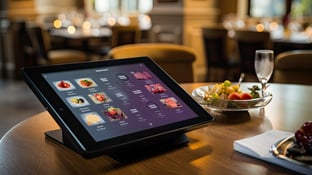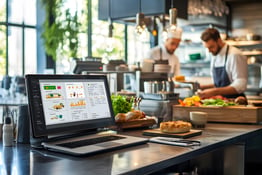Consumers today want fast, efficient dining experiences. But they also want quality service. How can restaurants provide both? For many restaurants, self-ordering kiosks are helping make this possible.
As Rob Connors tells us, kiosks in restaurants are helping to improve customer experiences, lower labor costs, and increase revenue. Rob is the Head of Partnerships for INFI, an innovative provider of both self-ordering kiosks and the software used to power them. INFI provides a combination of tablets and kiosks to a wide range of clients, including restaurants, food trucks, bowling alleys, indoor entertainment venues, and more.
We caught up with Rob to find out how restaurants are using kiosks to drive business improvements, especially those in the Quick Service Restaurant (QSR) sector, where speed and convenience are top priorities.
What Are Self-Ordering Kiosks and How Do They Work?
Self-ordering kiosks are touch-screen based devices that can be strategically placed in restaurants and in other commercial spaces where food is served or sold. Kiosks can come in a variety of physical forms including:
- Stand-alone kiosks
- Counter-top monitors
- Wall-mounted terminals
- On-table tablets
Self-ordering kiosks allow customers to view your restaurant’s digital menu, make selections, place orders, and process payments. And with a service provider like INFI, this digital menu is highly customizable. You can tailor this platform to:
- Feature your branding
- Promote certain menu items
- Highlight specific add-ons for customers as they order
- Integrate with your customer loyalty program
So how exactly can these features improve your business operations?
5 Ways Self-Ordering Kiosks Can Help Your Restaurant
Rob brings a unique perspective to the conversation. Rob’s work with INFI perfectly combines his upbringing in the hospitality-intensive Napa Valley and his 20 years of experience as a growth strategist.
This means that Rob has a strong appreciation for the importance of both efficiency and human engagement. He explains how kiosks in restaurants can help your operation maximize both.
1. Reduced Friction For Customers
Self-ordering kiosks can take a lot of the bottlenecks out of the ordering and payment processes for your customers. This is especially true, says Rob, for restaurants that are in high-density areas.
“Take, for example, a coffee shop in New York. You walk in, the line is six people deep, and someone's looking at the menu. They're staring up, and they don't know what to order. Living in New York, you just turn around and say, ‘Yeah, I'm going across the way.’”
This is the perfect example of a situation where a self-ordering kiosk might have prevented your business from losing a customer. The reality is that nobody, especially quick-service customers, wants to wait in line.
“The kiosk can eliminate that friction,” says Rob. The result, according to INFI customer surveys, is a 23% increase in customer satisfaction for restaurants that implement self-ordering kiosks.
2. More Opportunities to Increase Check Sizes
Self-ordering kiosks not only speed up the customer experience, they also provide opportunities to encourage additional spending. As Rob explains, in addition to hosting a digital menu, INFI kiosks use AI to identify and seize opportunities for on-screen advertising, cross-selling, and upselling.
One reason kiosks are so effective in these areas, says Rob, is that they can take some of the pressure out of ordering. Customers tend to behave differently when they have five people waiting behind them in line at an ordering counter.


Subscribe to Our Monthly Operations Newsletter
Learn how to streamline your processes, cut costs, and run a more efficient restaurant.
By contrast, “kiosks allow you to kind of run at your own pace,” says Rob. It turns out that customers may be more receptive to cross-promotions and upselling when ordering at their own pace.
According to INFI’s most recent customer survey, restaurants that have added self-ordering kiosks have seen a 25% increase in the average check size.
3. Reduced Labor Costs
Not only do self-ordering kiosks help your restaurant make more money, but they can also help you spend less.
For one thing, INFI reports, restaurants that implement kiosks experience a 30% reduction in their front-of house labor costs. But this isn’t necessarily because self-ordering kiosks are replacing human workers. Instead, self-ordering kiosks are freeing up front-of-house workers to focus on the details that can improve the customer experience.
As we noted at the beginning of our conversation, today’s customer expects both operational efficiency and quality service. Ideally, your restaurant should seek to “provide an experience where it's a combination of the two,” says Rob, “not eliminating the cashier, not eliminating that person, but repurposing that person to provide a better customer experience.”
While customers order using self-serve kiosks, real employees can focus on elevating human engagement at other points in the quick service or fast casual dining experience.
Rob explains that “if you repurpose your cashiers, they can be wiping down the counters. They can be cleaning out your displays. They can be greeting people and focusing on improving the customer experience and customer satisfaction.”
4. Multiplying Productivity
Rob also points out that the benefits of self-ordering kiosks are not limited to QSR and fast-casual chains. In fact, kiosks can be beneficial for all kinds of smaller quick serve operations with limited staff and high customer traffic, including concession stands, food trucks, stadiums, food halls, and prepared foods counters at grocery stores or delis.
As Rob explains, “Sometimes, the smaller restaurants don't necessarily have the resources, and that's why they will actually use a kiosk. Maybe you have a wing shop or you're serving bahn mi sandwiches or bubble tea…maybe you have five staff members in total, and you need your cashier to be working as a barista at the same time.”
For smaller operations, where every staff member wears multiple hats, kiosks can be a force multiplier. Rob notes that “this is where it really helps to have a kiosk in place of people taking the orders, which can otherwise take away from the time that they're using delivering products to people.”
5. Easy Integration and Quick Implementation
Today, kiosks in restaurants can also integrate seamlessly with existing technology platforms. For instance, if you have a modern POS (point of sale) system like Square or Toast, kiosk vendors like INFI provide full, customized integration. Rob explains, “We have native integrations that we do with all of our POS partners out there, and also with our payment processors.”
This also means that you can connect your kiosk to a handful of other important restaurant functions. For example, “maybe you want to do specials of the day, discounts, loyalty programs – all of that stuff can be incorporated into your software.”
And, says Rob, the speed of implementation is usually about three weeks from the time you order your kiosk to the time your customized terminal is ready for your customers. The speed of implementation and the easy integration with most restaurant technologies help minimize the disruptions that sometimes occur when you add new technology to the mix.
Rolling Out a Self-Ordering Kiosk In Your Restaurant
Not sure whether a kiosk is right for your restaurant? Rob offers an important word of parting advice.
“Don't fear new technology,” he suggests. “As humans, we have an innate ability to adapt. The technology is here, and we have to be able to embrace that.” But of course, you still want to do your due diligence before adding a bunch of new tech to your restaurant.
“Instead of fearing the technology and backing away,” advises Rob, “it's a matter of just asking more questions about it.”
If you’ve got questions, we’re here to answer them. Reach out today and schedule your personalized consultation.





